NCERT Solutions for Class 5 EVS Chapter 11 - Sunita in Space
Straight from the Heart
Q1: What do you think the earth looks like? Make a drawing of the earth in your notebook.
Ans:
- The Earth looks like a sphere. It is mostly round, like a ball, but it is slightly flattened at the top and bottom (the North and South Poles).
- When you draw the Earth, you can show it with blue oceans and green land, along with clouds and polar ice caps!
Here is one example drawing:

What do you think?
Q.1. If the Earth is round like a globe, how is it that we do not fall off?
Ans:
- We do not fall off because of gravity.
- Gravity pulls everything toward the center of the Earth.
- This force keeps us and all objects firmly on the ground.
Q.2. Do the people in Argentina stand upside down?
Ans:
- No, people in Argentina do not stand upside down.
- Gravity pulls everyone toward the center of the Earth, so people stand ‘upright’ relative to the ground, no matter where they are.
- There’s no absolute ‘up’ or ‘down’—it’s all relative to your position on the globe.
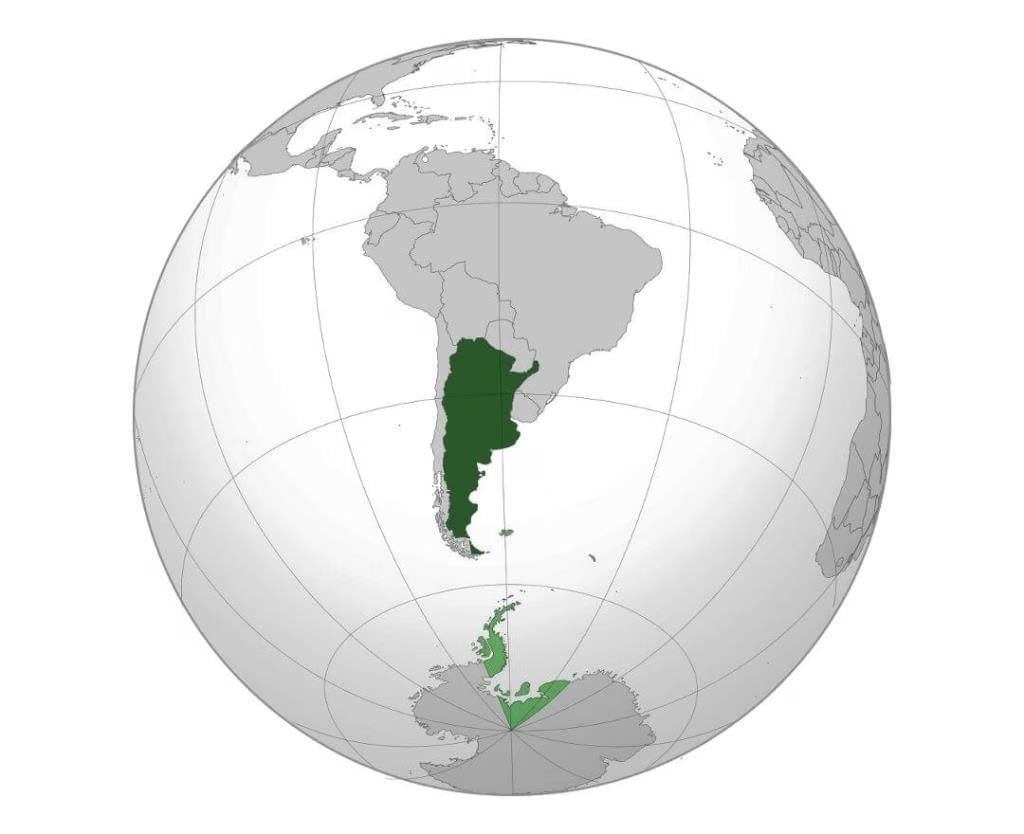
Look at the photographs and write
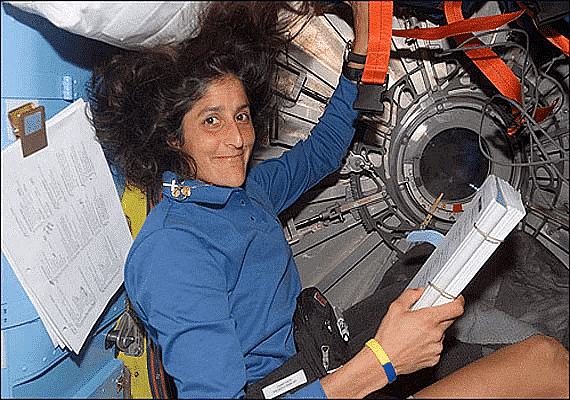 Sunita William's standing hair
Sunita William's standing hair
Q1: Can you think why Sunita’s hair was standing?
Ans: We know that on earth, our hair remains in a downwards portion due to the earth’s gravitational force. But in space, there is no such gravitational force. That is why Sunita’s hair was standing.
Q2: Look at Sunita’s photographs and the dates written on each of them. Write what is happening and when.
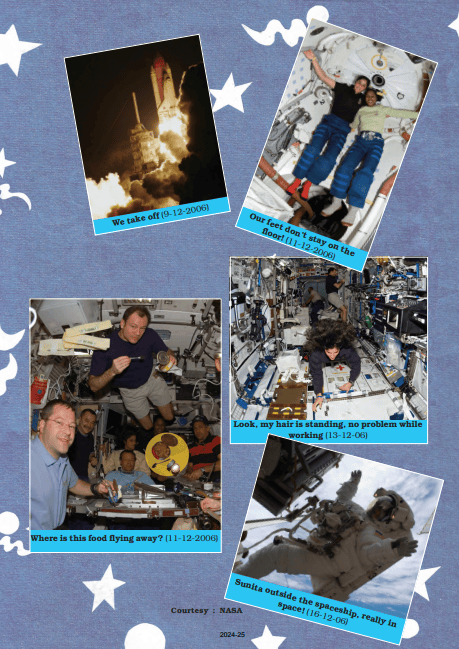
Ans.

Classroom becomes a spaceship
Q: Close your eyes. Imagine that your class is a spaceship. Zooo…m – in 10 minutes you have entered space. Your spaceship is now going around the earth. Now say: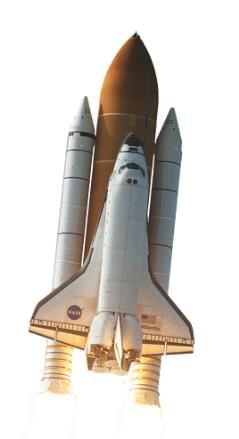 Spaceship
Spaceship
- Are you able to sit in one place?
Ans: No I am not able to sit in one place, everyone seems to be floating inside the spacecraft. - What about your hair?
Ans: My hair too seems to be standing up. - Oh, look … where are your bags and books going?
Ans: My books and bags are floating inside the spacecraft. - And what is your teacher doing? Where is her chalk?
Ans: My teacher too is floating inside the spacecraft and trying to catch the chalk which is also floating. - How did you eat your food during the break? How did you drink water? What happened to the ball that you threw up?
Ans: To eat our food, we had to grab the food items and have them. The water was in the form of blobs we had to suck them in. The ball which we threw up was also floating.
Isn't it Amazing
Q1: Can you now say why Sunita’s hair kept standing?
Ans: Sunita’s hair kept standing because there is no gravitational pull in space.
Q2: Think why water flows downwards on any slope? In mountains, too water flows downwards, not upwards?
Ans:
- Water flows downwards on slopes and mountains because of the force of gravity.
- Gravity pulls everything toward the center of the Earth, causing water to move from higher elevations to lower ones.
- This is why rivers and streams flow downhill instead of uphill.
 Flowing Water
Flowing Water
Magic 1 – A tiny paper races a coin
Q1: Take a 5 rupee coin and a small piece of paper. The paper should be about one-fourth the size of the coin.
- Hold the coin in one hand and the paper in the other. Drop them at the same time. What happened?
- Now place the tiny paper on the coin and drop them. What happened this time? Surprised!
Ans.
- When dropping the coin in one hand and the paper in the other, the coin reaches the ground faster than the paper.
- When placing the tiny paper on the coin and dropping them together, both reach the ground at the same time.
Reason:
When you drop the coin and the paper separately, the coin reaches the ground faster than the paper. This is because the paper is lightweight and affected by air resistance, which slows it down as it falls.
When you place the tiny paper on top of the coin and drop them together, they both reach the ground at the same time. This happens because the coin's weight helps overcome the air resistance acting on the paper, allowing them to fall together as one object.
This experiment demonstrates how gravity works along with the effects of air resistance on different objects.
Magic 2 – A mouse lifts an elephant!
Q1: To play this you will need a small stone, a bigger stone (lemon-sized), a thick roll of paper (which can be made with layers of paper), a mouse and an elephant made of paper.
- Take a string about 2 feet long.
- At one end of the string tie the small stone. Stick or tie the mouse to the stone.
- Put the string into the roll of paper.
- At the other end of the string tie the bigger stone and stick the elephant.
- Hold the roll of paper and move your hand to rotate the small stone.
- Who is pulling whom? You will be surprised! The mouse lifts the elephant!
How did this magic happen?
Ans:
- When the small stone (the mouse) spins, it pulls on the string.
- This pull travels through the string to the bigger stone (the elephant).
- As the small stone turns, it helps lift the bigger stone up.
- The roll of paper acts like a lever, giving the small mouse extra power to lift the heavier elephant.
- This shows how forces and simple machines can do amazing things
Look at this photograph and tell
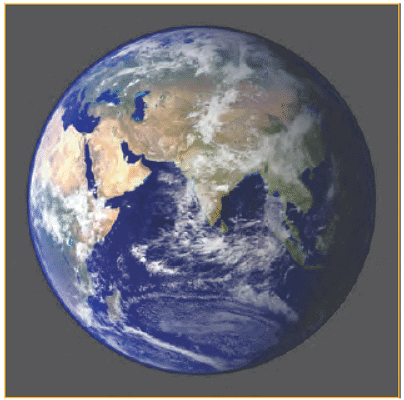
Q1: Can you see India?
Ans: Yes, I can see India in the picture but not very clearly.
Q2: Can you recognize any other place?
Ans: It is difficult to recognize any other place exactly in the photograph, as specific countries are hard to identify from space without visible borders.
Q3: Where is the sea?
Ans: The blue part of the picture is the sea.
Q4: Do you find anything similar between the globe and this picture of the earth? In what way are they different?
Ans:
Similarities:
- Both the globe and the picture of the Earth show the same basic features, like land and water.
- You can easily identify which areas are land and which are sea on both.
Differences:
- A globe shows countries and states divided, while the picture does not.
- A globe is a 3D representation, while this picture of the Earth is 2D, making the globe more realistic.
Q5: Do you think Sunita could make out Pakistan, Nepal and Burma separately when she saw the earth from space?
Ans: No, it is difficult to identify these countries, since no particular country is visible from space.
Look at the globe in your school and tell

Q1: Could you find India?
Ans: Yes, we can easily find India.
Q2: Where do you find the sea?
Ans: The blue parts of the globe are seas.
Q3: Which countries can you see?
Ans: I can see all countries like India, Pakistan, China, Bangladesh, Sri Lanka, Indonesia, Singapore, USA, Russia, France, Britain, Germany, Mexico etc.
Q4: Can you see some of the countries with which India plays cricket matches? For example: England, Australia, Pakistan, Bangladesh and South Africa.
Ans: Yes, I can see all these countries.
Q5: What else can you see on the globe?
Ans: Apart from sea and countries, I can see islands, mountains etc. on the globe.
Look at the map of your country and tell
Q1: Can you find the state in which you live? Write its name on the map.Ans: Yes, I can find Delhi the place I live in.
 Q2: Which are states next to your states?
Q2: Which are states next to your states?Ans: Delhi is between Haryana and Uttar Pradesh.
Q3: Have you been to any other state?
Ans: Yes. I have been to many states like Uttar Pradesh, Haryana, Punjab, Himachal Pradesh etc.
Q4: Shahmir thinks that there are lines drawn on the ground, between the states. What do you think?
Ans: There is no such line made on the ground, between the states. It’s all on the map only.
Look at the sky
1. Why don’t you try to do the same with a coin? How many centimetres away from the eye did you keep the coin to hide the moon
Ans. To hide the moon completely, the coin has to be kept at 25 centimetres away from the eye.
Think
Q1: Do you think the moon is flat like a coin or round like a ball?
Ans: I think the moon is round like a ball.
Q2: Look at the moon tonight and draw what it looks like. Look and draw again after one week, and then after 15 days.
Ans:
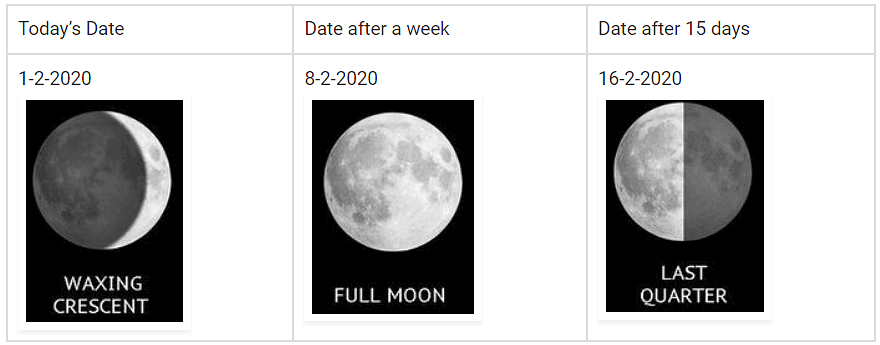 The different phases of the moon are
The different phases of the moon are

Find Out
Q1: When is the next full moon? At what time will the moon rise on this day? What does the moon look like on this day? Draw it.
Ans: The next full moon is on the 8th of this month. It rises just after the sun sets. The moon looks like a complete white circle.
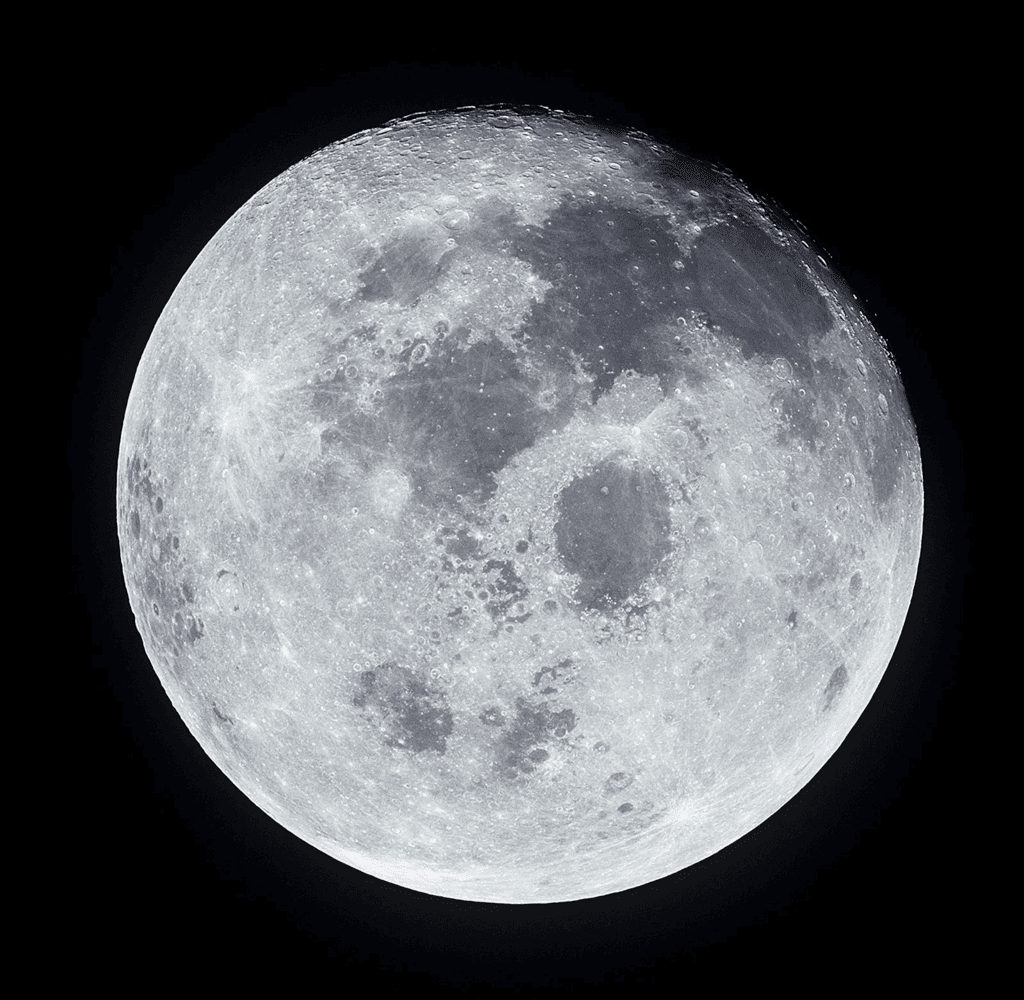 Full Moon
Full Moon
Q2: What are the festivals related to the moon?
Ans: There are many festivals related to the moon like Eid, Karwachauth etc.
Q3: At night look at the sky carefully for 5 minutes. What could you see?
Ans: At night, I could see the moon and the stars.
Q4: Did you see anything moving in the sky? What do you think it could be? A star or a shooting or a satellite (satellites are used for the TV, telephones, and for weather reports). Find out more about this.
Ans: Yes, I saw something moving in the sky. It might be a shooting star, also called a meteorite, which moves quickly and looks bright because it burns up due to friction when entering the Earth’s atmosphere. If it were a satellite, it would move much more slowly
Look at the table and Tell
Q1: Given below are the times at which the moon rises and sets in Delhi (on the given days).

- On 28 October the moon came out at ___ minutes past ___ o’clock.
- On 29 October the moon came out at ___ minutes past ___ o’clock.
- On 29 October there was a difference of ___ hours and ___ minutes in the time of the moon rise (as compared to 28 October).
Ans:
- On 28 October the moon came out at 16 minutes past 7 o’clock.
- On 29 October the moon came out at 17 minutes past 8 o’clock.
- On 29 October there was a difference of 1 hour and 1 minute in the time of the moon's rise (as compared to 28 October).
Q2: If you saw the moon rising at 7 pm today, would you see it at the same time tomorrow?
Ans: No, the moon rises at different times on different days.
Q3: On 31st October the time of setting of the moon is given as 12:03. Have you ever seen the moon at 12 in the afternoon? Why don’t we easily see the moon or stars during the day?
Ans: No, I have not seen the moon at 12 in the afternoon. Due to the dominating sunlight during the day, we cannot see the moon or stars during the day.
An Interesting Photograph
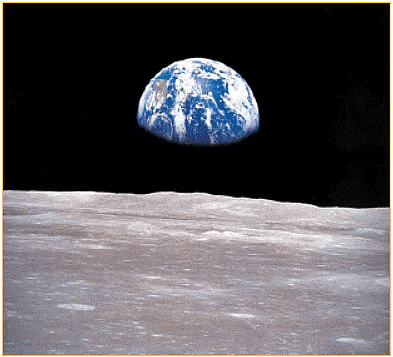
Q1: A spaceship went to the moon. This photograph of the earth was clicked from the surface of the moon. See how the earth is looking. Can you see the surface of the moon? Do you have some questions after looking at this picture? Write down those questions and discuss them in class.
Ans: Yes, I can see the surface of the moon is clearly visible. There are a few questions running through my mind:
- Who clicked this picture?
- How could they land on the moon?
- How was their experience seeing the earth from the moon?
- Does water or air exist on the moon?
What we have Learnt
Q1: Why do children always slide down the slide and not slide up? If this slide were there in Sunita’s space, would children slide like this? Why?
Ans:
- Children slide down the slide because of gravity, which pulls everything towards the Earth.
- If the slide were in Sunita’s spacecraft, children wouldn’t slide down. This is because there is zero gravity in space, so they would float instead of sliding.
Q2: Why do we see stars mostly at night?
Ans:
- We see stars mostly at night because there is no sunlight.
- When it’s dark, the light from the stars can reach us, and that’s why we can see them.
Q3: Looking at the earth from space, Sunita said, “Different countries cannot be seen as separate from her. These lines are on paper. They are made by us. What do you understand by this?
Ans:
- Sunita means that the boundary lines that separate countries are not natural.
- These lines are created by humans to help us understand where one country ends and another begins.
- From space, we can’t see these lines; we just see the Earth as one big planet without borders.
|
37 videos|244 docs|41 tests
|
FAQs on NCERT Solutions for Class 5 EVS Chapter 11 - Sunita in Space
| 1. What is the main theme of the article "Sunita in Space"? |  |
| 2. How does the article encourage students to think about space exploration? |  |
| 3. What can students learn from Sunita Williams' journey? |  |
| 4. How can students use their school globe to explore geographical concepts related to space? |  |
| 5. Why is it important to have role models like Sunita Williams in education? |  |






















